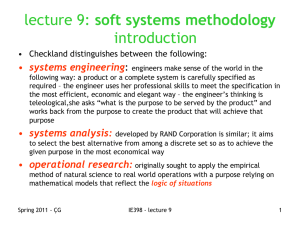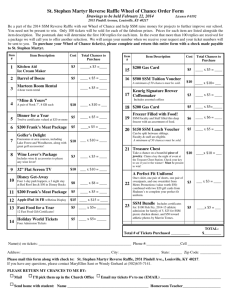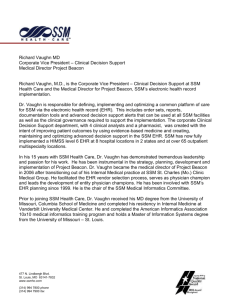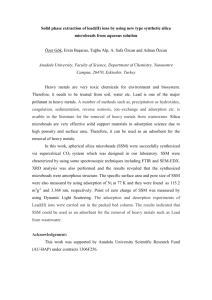Surveys and Negligence
advertisement
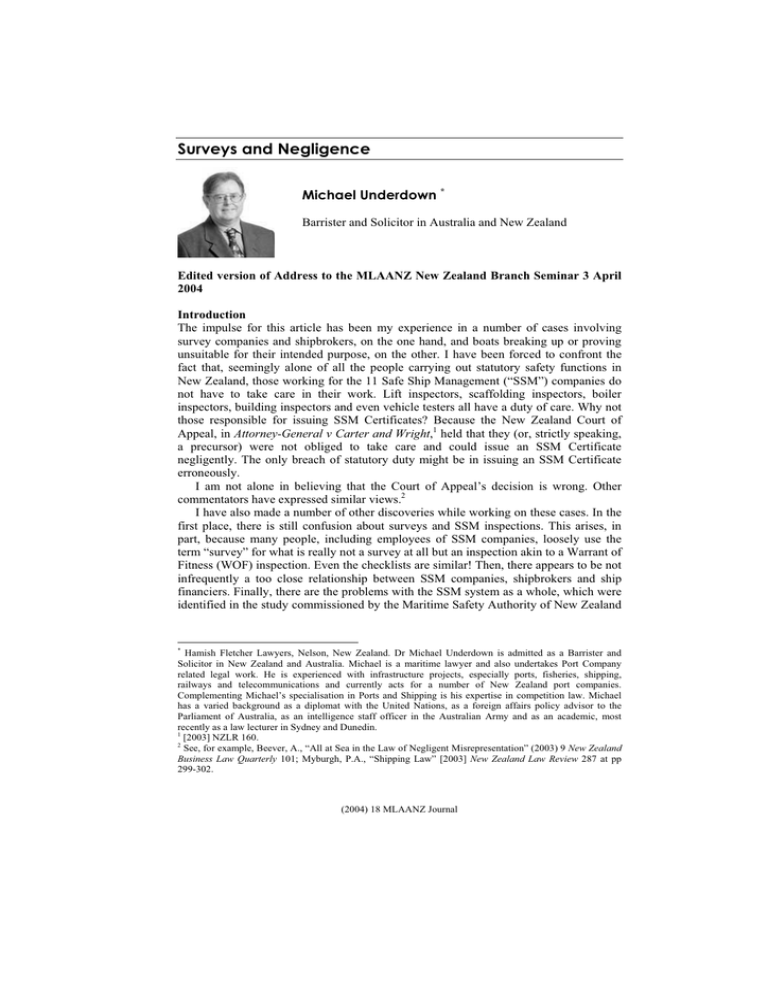
Surveys and Negligence Michael Underdown * Barrister and Solicitor in Australia and New Zealand Edited version of Address to the MLAANZ New Zealand Branch Seminar 3 April 2004 Introduction The impulse for this article has been my experience in a number of cases involving survey companies and shipbrokers, on the one hand, and boats breaking up or proving unsuitable for their intended purpose, on the other. I have been forced to confront the fact that, seemingly alone of all the people carrying out statutory safety functions in New Zealand, those working for the 11 Safe Ship Management (“SSM”) companies do not have to take care in their work. Lift inspectors, scaffolding inspectors, boiler inspectors, building inspectors and even vehicle testers all have a duty of care. Why not those responsible for issuing SSM Certificates? Because the New Zealand Court of Appeal, in Attorney-General v Carter and Wright,1 held that they (or, strictly speaking, a precursor) were not obliged to take care and could issue an SSM Certificate negligently. The only breach of statutory duty might be in issuing an SSM Certificate erroneously. I am not alone in believing that the Court of Appeal’s decision is wrong. Other commentators have expressed similar views.2 I have also made a number of other discoveries while working on these cases. In the first place, there is still confusion about surveys and SSM inspections. This arises, in part, because many people, including employees of SSM companies, loosely use the term “survey” for what is really not a survey at all but an inspection akin to a Warrant of Fitness (WOF) inspection. Even the checklists are similar! Then, there appears to be not infrequently a too close relationship between SSM companies, shipbrokers and ship financiers. Finally, there are the problems with the SSM system as a whole, which were identified in the study commissioned by the Maritime Safety Authority of New Zealand * Hamish Fletcher Lawyers, Nelson, New Zealand. Dr Michael Underdown is admitted as a Barrister and Solicitor in New Zealand and Australia. Michael is a maritime lawyer and also undertakes Port Company related legal work. He is experienced with infrastructure projects, especially ports, fisheries, shipping, railways and telecommunications and currently acts for a number of New Zealand port companies. Complementing Michael’s specialisation in Ports and Shipping is his expertise in competition law. Michael has a varied background as a diplomat with the United Nations, as a foreign affairs policy advisor to the Parliament of Australia, as an intelligence staff officer in the Australian Army and as an academic, most recently as a law lecturer in Sydney and Dunedin. 1 [2003] NZLR 160. 2 See, for example, Beever, A., “All at Sea in the Law of Negligent Misrepresentation” (2003) 9 New Zealand Business Law Quarterly 101; Myburgh, P.A., “Shipping Law” [2003] New Zealand Law Review 287 at pp 299-302. (2004) 18 MLAANZ Journal Surveys and Negligence 25 (“MSA”) and undertaken by Thompson Clarke Shipping Pty Ltd in association with Rutherford Sloan Ltd and Marketmetrics Pty Ltd.3 These matters are disturbing enough for practitioners, but they are even more so for those who have to go to sea in negligently checked boats and for the marine insurers who — thanks to the Court of Appeal decision — have to pay out for the consequences of carelessly performed inspections. Attorney-General v Carter This case arose prior to the introduction of the SSM system in New Zealand on 1 February 1998.4 Nevertheless, it did concern the issue of a survey certificate under the then current Shipping and Seamen Act 1952 (NZ). The respondents alleged that the survey had been carried out negligently and that as a consequence they had suffered loss and damage. They claimed in negligence and for breach of statutory duty. The Court, however, held that the survey company owed no duty of care to the respondents since the purpose of providing the certificate was to ensure their safety at sea and the seaworthiness of their vessel (section 199 of the Shipping and Seamen Act), not to avoid harming their business interests. A survey certificate could not be relied on as confirming that the vessel was fit for the purpose of fishing, even though section 206(2) of the Shipping and Seamen Act stated that the purpose of the statutory surveys was “to determine … whether or not the ship is in all respects satisfactory for the service for which the ship is intended to be used.”5 In my view, this purpose seems to go beyond simply ensuring safety at sea and seaworthiness of vessels. Incidentally, Part 46 of the Maritime Rules promulgated under the Maritime Transport Act 1994 (NZ) provides that surveyors undertaking surveys of new ships, existing ships and barges must be satisfied that the structure and equipment of the vessel are “in satisfactory condition and fit for the service for which it is intended”.6 And the MSA itself, on its SSM website, states that “design and construction will have to be checked as being “fit for purpose … [and] all structural engineering, electrical, sanitation, fire protection, anchoring and pumping arrangements will have to be in accordance with the Rules and fit for purpose”. “Fitness for purpose” is, of course, a term used in consumer protection law, and specifically in section 29 of the Consumer Guarantees Act 1993 (NZ) with regard to the supply of services. However, there is no reason why a similar approach should not be taken by the courts with respect to SSM inspections as is taken with guarantees of fitness for purpose and the related guarantee that services will be carried out with reasonable care and skill contained in section 28 of the Consumer Guarantees Act. The Court of Appeal was also just plain wrong in stating that there is no difference between “safety” and “seaworthiness”. These are quite well understood concepts in maritime law, as evidenced by section 40 of the Marine Insurance Act 1908 (NZ). Arguably, even if it is not possible to recover pure economic loss (loss unconnected with and not flowing from physical damage to property or person), financial loss is 3 Thompson Clarke Shipping Pty Ltd Review of Safe Ship Management Systems Maritime Safety Authority of New Zealand (Wellington, September 2002) (“Thompson Clarke Report”) available at http://www.msa.govt.nz/Publications/publications/SSMReview_FinalReport.pdf (21 April 2004). 4 The certificate of survey referred to in Part 21 of the Maritime Rules, Rule 21.11 with respect to fishing vessels was replaced by the SSM Certificate with effect from 5 February 1998. 5 Emphasis added. 6 Emphasis added. See Part 46 (Surveys, Certification and Maintenance) of the Maritime Rules, Rules 46.5(2)(b), 46.6(2)(b)(i), 46.6(4), 46.6(5)(b), 46.6(6), 46.6(7), 46.7(2)(b), 46.7(3), 46.7(4), 46.13, 46.14, 46.23(2)(b), 46.23(3)(b) and 46.23(4)(b). (2004) 18 MLAANZ Journal 26 Michael Underdown recoverable where the loss was foreseeable and consequent on physical damage to the property. Of course, if you are a skipper whose boat is breaking up in heavy seas as a consequence of a negligent survey, as in the case of the Owenga 8 at Westport in New Zealand in 2001, it is a legal nicety whether it is your life or your livelihood that is in danger. Surveys and SSM There have always been, and still are, a wide range of ship surveys, including prepurchase surveys, valuation or insurance appraisal inspections, insurance surveys and damage surveys. One of the problems, as I have already noted, is that both “old salts” and those working in the SSM companies sometimes use the term “survey” to mean different things. In particular, it needs to be emphasised that somebody contemplating purchasing a vessel requires a pre-purchase survey and/or a valuation or insurance appraisal inspection. An SSM Certificate can only be issued to someone who already owns a vessel. A particular problem arises when prospective boat owners are talked out of a prepurchase survey by an SSM company. This normally occurs along the following lines: “You don’t need one. She was surveyed recently. Don’t worry, we’ll see she gets a certificate.” In fact, the boat may perhaps have been surveyed 2 years earlier. The effect is that what would definitely have been a contractual relationship between a contemplating purchaser and a ship surveyor becomes a relationship between somebody “pressured” into purchase and an SSM company. It has been put to me that the relationship between an SSM company and the MSA is “inconsistent with a contractual relationship” between the SSM company and the ship owner. This may be correct insofar as it relates solely to inspections for the purposes of issuing an SSM Certificate, where what we have is really payment for a licence, although in my view a distinction still has to be drawn between a public servant and a company contracted (in this case, quasi-self-appointed even if approved) to undertake some regulatory function (a distinction recognised in the non-applicability of the tort of misfeasance in public office to the latter). However, in the case of ship surveys — as distinct from SSM inspections — there very definitely is a contractual relationship between the boat purchaser/boat owner and the survey company. It is important to stress that the current SSM system only replaced the former system of periodic annual surveys that mainly applied to larger commercial vessels. It was not intended to, and does not, replace all the other ship surveys, even though the New Zealand Parliament envisaged that periodic inspection would cover the “hull, machinery and systems” of ships (section 36(f) of the Maritime Transport Act 1994 (NZ)), and if carried out with care such inspection or testing would greatly enhance safety and seaworthiness. Negligence and duty of care There is now a considerable body of case law on the subject of duty of care. However, I think a useful starting point for present circumstances is the judgment of Lord Cooke (then Cooke J) in Rutherford v Attorney-General.7 This case arose from the negligent issue of a certificate of fitness (not a WOF) by a Ministry of Transport testing station. 7 [1976] 1 NZLR 403. (2004) 18 MLAANZ Journal Surveys and Negligence 27 Lord Cooke said that, “since the ministry alone could authorise its [ie the certificate’s] lawful use … there was a monopoly situation … [and] a particularly clear instance of control of events by a defendant”. The SSM system is operated by MSA-approved survey companies, but in all other respects the situation is no different from that described by Lord Cooke. Incidentally, Lord Cooke’s reasoning in Rutherford was subsequently adopted with approval by the Court of Appeal.8 Lord Cooke also said that, where there was no specific statutory remedy for a negligently issued certificate, relevant common law principles applied. It was in the public interest that there should be a remedy, although he was reluctant to allow recovery of full economic loss. He would, however, allow the cost of work identified by a reasonably careful inspection as necessary to permit the granting of a certificate. Of course, the real starting point for any discussion of negligence is the situation prior to Donoghue v Stevenson,9 namely, that a duty of care existed only when there was a specific relationship between the parties. This was replaced by the concept that a duty of care was owed to those who should have been considered as likely to be harmed. The next major development was Hedley Byrne Co v Heller & Partners Ltd,10 which held that there was a duty of care for negligent statements occasioning economic loss provided there was a special relationship between the parties.11 The logical extension of this line was the judgment in Home Office v Dorset Yacht Co Ltd,12 followed by the well-known decision in Anns v Merton London Borough Council13 in which Lord Wilberforce proposed a two-stage test: (a) determining whether there was a sufficient relationship of proximity that one party could reasonably have foreseen that its carelessness might be likely to harm the other party, and (b) considering whether there were any factors that should limit the scope of the duty. There has since been a move away from this approach in both England and Australia, but not in Canada, where the greater degree of flexibility of an incremental approach is preferred.14 An important step along this road in England was taken in Yuen Kun-yeu v Attorney-General of Hong Kong,15 until Anns was finally overruled in Murphy v Brentwood District Council.16 However, there has been a more recent shift with regard to pure economic loss, with the House of Lords deciding in Henderson v Merrett17 that, subject to policy considerations, the Hedley Byrne principle with regard to negligent statements extends to a wide range of services, including negligent performance of duty and omissions (the “assumption of responsibility” test). In New Zealand, the courts have tended to adopt what has been described as a “control-reliance” approach, which considers whether a statutory authority such as the MSA “has assumed control for the conduct of its activities by third parties or has 8 See, for example, South Pacific Manufacturing Co Ltd v New Zealand Security Consultants & Investigations Ltd [1992] 2 NZLR 282 (CA). 9 [1932] AC 562 (HL). 10 [1964] AC 465 (HL). 11 The Australian approach of recognising a duty of care for a negligent misstatement where there is known reliance or an assumption of responsibility was confirmed by the High Court of Australia in Perre & Ors v Apand Pty Ltd (1999) 198 CLR 180. 12 [1970] AC 1004 (HL). 13 [1978] AC 728 (HL). 14 The original Canadian test was formulated in Kamloops v Nielsen [1984] SCR 2 (SCC). There is a common assumption that there has been an over-generalisation with respect to economic loss claims. 15 [1987] 2 All ER 705 (PC). 16 [1991] 1 AC 398 (HL). 17 [1994] 3 All ER 506 (HL). (2004) 18 MLAANZ Journal 28 Michael Underdown created a situation in which the public is entitled to rely upon its careful exercise of powers”.18 In my view, cases involving negligent performance of SSM inspections are clearly encompassed both by this approach and that of the House of Lords. We are not talking of third parties, like the cargo interests in Marc Rich & Co AG & Ors v Bishop Rock Marine Co Ltd & Ors (The “Nicholas H”),19 where Lord Steyn for the majority said that, even assuming a sufficient degree of proximity, it would not be “fair, just and reasonable” to impose a duty of care on a surveyor of whose services the cargo owners were ignorant. This is far from the situation of a skipper seeking an SSM Certificate from an SSM company. Looking more generally at the issue of liability, we find that the MSA Advisory Circular to Part 46 of the Maritime Rules refers to the fact that surveyors undertaking surveys prior to a ship’s entry into the SSM system take “full responsibility” for that survey. This can, of course, be read two ways, but any surveyors who are members of a recognised professional association, such as the International Association of Marine Surveyors, will adhere to a Code of Conduct requiring them to exercise care and skill in the performance of their work. Put simply, a marine surveyor should be expected to exercise the degree of care and skill of a reasonably competent marine surveyor of similar experience. Why should a marine surveyor exercise a lesser duty of care than a salvor, who has always owed a duty of care to the owners of the salved property?20 Breach of statutory duty An action in tort for breach of statutory duty involves having an express or implied right to sue for a breach of that statutory duty. Contrary to the Court of Appeal decision in Attorney-General v Carter, it is particularly in situations involving public safety that such a right will be implied if there is no express statutory right. For example, there have been several cases in Australia in which electricity companies have been held liable for damage caused by fires sparked by faulty power lines.21 It is not questioned that the SSM system is intended to ensure the safety of mariners and the seaworthiness of their vessels. The two main tests applied by the courts in such cases are the “class” test and the “alternative modes of enforcement” test.22 The former test, which was referred to in Attorney-General v Carter, takes into account whether the relevant legislation benefits an ascertainable class of persons. The SSM system applies expressly to registered owners of ships (Maritime Rules, Rule 21.2), a class that is quite specific and readily identifiable. The latter test would involve ascertaining whether an SSM company failed to conduct an SSM inspection in such a manner as to ensure safety at sea and seaworthiness of a vessel. The fact that it is an offence to put to sea without a valid SSM Certificate (under section 144(2) of the Maritime Transport Act 1994 (NZ)) lends weight to the inference that the New Zealand Parliament must have intended that those charged with the sole 18 See Kneebone, S., Tort Liability of Public Authorities, LBC, North Ryde, 1998 at 78. [1996] 1 AC 211. See The “Tojo Maru” [1972] AC 242 for a full discussion of the cases. 21 See JD Bell (Calool) Pty Ltd v Shortland County Council (1991) ATR 81-1329; Telfer & Anor v Flinders Ranges Council & Ors (No 2) [1999] SASC 117. 22 There is no test in New Zealand akin to the Canadian “policy vs operational” test. See Just v British Columbia [1989] 2 SCR 1228. 19 20 (2004) 18 MLAANZ Journal Surveys and Negligence 29 responsibility for managing the statutory SSM scheme would be civilly liable for any breach of their statutory duty. Thompson Clarke Report As mentioned already, a number of problems with the current SSM system were identified in the Thompson Clarke Report, some of which are more relevant than others to the matters I have been addressing. Just four SSM companies handle 97% of SSM business in New Zealand, with one company being responsible for approximately 50% of the total market. The upshot is that there are virtually local monopolies in many places. Furthermore, many SSM companies are not meeting even minimum competence and procedural requirements, a deficiency made worse by the fact that the SSM system is not governed by a contract for service provision. We have, in effect, a form of regulatory capture, which the MSA needs to address. As the Report points out, a similar change in the survey system has occurred in Australia, but there the change in emphasis “is based on sound administrative arrangements with the Classification Societies, a rigorous quality assurance system and high standards of surveyor training”.23 Conclusion Murphy J of the High Court of Australia in Caltex Oil (Australia) Pty Ltd v The Dredge “Willemstad”,24 a case arising from the rupture of oil pipelines on the bed of Botany Bay by the dredge Willemstad, said:25 Social responsibility carries with it a duty of care and liability for damage caused by breach of this duty. Persons causing damage by breach of duty should be liable for all the loss unless there are acceptable reasons of public policy for limiting recovery. His Honour went on to point out that the usual objections raised to allowing recovery for economic loss, such as the desirability of avoiding multiple actions and the potential for huge damages awards, were easily resolvable. Representative (class) actions and joinder of actions, his Honour said, easily solved the former objection, while the state could readily limit its liability by legislation if social considerations so dictated. However, if the reforms proposed by Spigelman CJ, Chief Justice of New South Wales, in an address to the Judicial Conference of Australia in April 2002 entitled Negligence: the Last Outpost of the Welfare State are implemented, social considerations will largely give way to individuals taking responsibility for their own actions. In my view, the statement by Murphy J is not only an eminently sensible assessment of the issues involved in such cases, but also the morally right approach. It is high time for the MSA or New Zealand Parliament to take action to correct the anomaly I have been addressing, because if they do not do so very soon the marine insurance industry is likely to take matters into its own hands and mandate independent surveys before they write policies of marine insurance. Formal recognition of a duty of care by marine surveyors is one of the best means of promoting the safety of lives and seaworthiness that the SSM system is intended to achieve. 23 24 25 Thompson Clarke Report, above n 3, at pp 18-19. (1976) 136 CLR 529. Ibid, at p 606. (2004) 18 MLAANZ Journal
